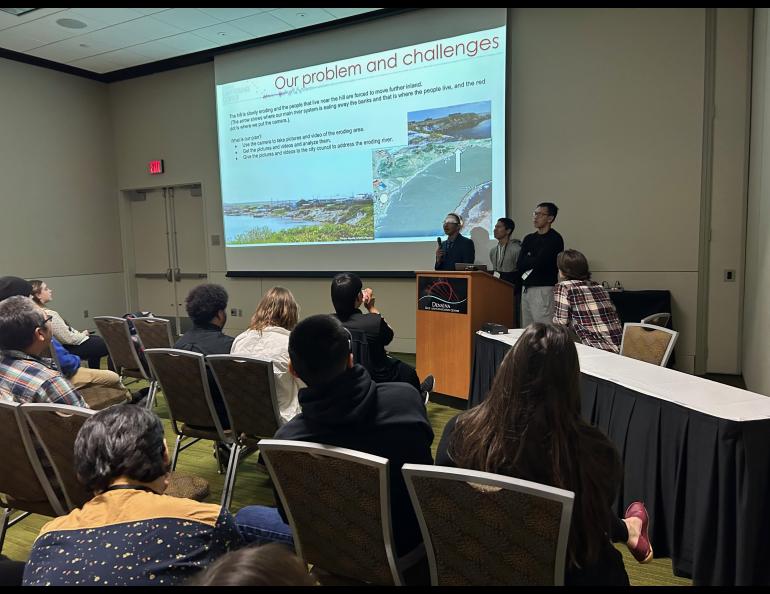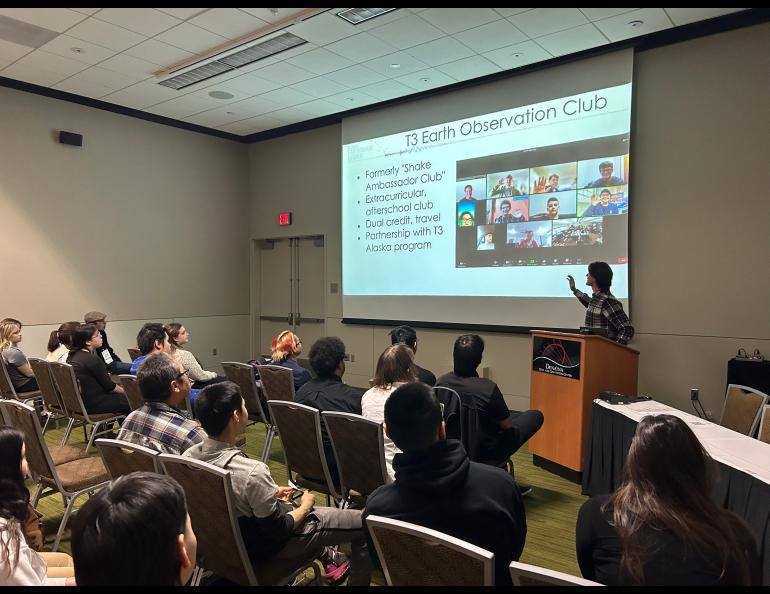Radiation monitoring. Sea ice changes. Floodwater alerts. Coastal erosion. Speeding drivers. Landslide warnings. Thawing permafrost. Weather stations. Bears.
Those seem like subjects or projects that university students and professionals would study or undertake, but they are also projects of talented Alaska high school students from many rural or remote communities.
About 30 of those students in the Earth Observation Club, an after-school program hosted by several rural Alaska high schools, presented their research at a Wednesday luncheon during the Seismological Society of America annual meeting in Anchorage.
The Earth Observation Club is part of the Teaching Through Technology Alaska program, also known as T3 Alaska. The program is an alliance of students, educators and community partners, and is run by the UAF College of Engineering and Mines.
The club, which is sponsored and organized by the Alaska Earthquake Center, is led by Gabriel Low, workforce development specialist with the Earthquake Center at the University of Alaska Fairbanks Geophysical Institute.
“In project-based learning, students can learn things but also really apply them,” Low said. “And in the T3 program, the community-engagement component is where students can do project-based learning, do cool projects, but directly relate them to a community need.”
These student-led projects do have community impact. The landslide warning project of students at Mount Edgecumbe High School in Sitka is just one example.
Sitka is in a mountainous rainforest. It receives about 90 inches of precipitation annually, most of that as rain. Periods of sustained heavy rain loosen the slopes.
The students on the Mount Edgecumbe High School project want to know when and where a landslide occurs, so they deployed two seismic sensors provided as part of the T3 Alaska project and hope to install more. They learn to distinguish the seismic signals of regular life, like traffic, from earthquakes that would cause the shaking that would trigger landslides
“It helps to warn the community when a landslide is going to happen,” student Sierra Isaak said after she and other students from around the state presented their work. “That way they are more prepared. They don't get hit by it.”
The students get something out of it, too. Fellow student Trevor Bereskin said the project taught him how to distinguish the origin of a seismic signal. “I learned how to differentiate between an explosion and an earthquake.”
Students came to the conference from Bethel, Chevak, North Pole, Quinhagak, Seward, Shishmaref, Sitka, Wrangell and the Kusilvak Career Academy in Anchorage.
Shishmaref, a coastal community on the Chukchi Sea coast of the northern Seward Peninsula, has been dealing with extensive coastal erosion. So much land has been lost to the sea that residents have twice voted to move their community, though they have yet to relocate.
Students in the Earth Observation Club from Shishmaref School wanted to monitor the sea ice to detect its movement. An ice wall had built up, but there was no record of how it happened, so the students mounted a camera on the teacher housing unit. They also buried a sensor in a hole 2 ½ feet deep to record ice movement.
“Our camera helps watch our ice when it breaks up,” student Makayla Nayokpuk said. “Researchers found it’s breaking up a lot faster than it should be.”
At North Pole, a small community east of Fairbanks, radiation was the subject. The Air Force wants to build a small self-contained nuclear power plant, called a microreactor, at Eielson Air Force Base. It will be the first such power plant to be built on a U.S. military base.
North Pole High School students are working with a University of California, Berkeley nuclear physicist who wants to set up radiation monitors in the area. The first will be on or near North Pole High School. The students are hoping to place a monitor close to Eielson Air Force Base.
Student Eldridge Gumbs said being on the school’s team has taught him about the different types of radiation.
“I was able to learn about alpha radiation, beta radiation and gamma rays,” he said.
Students previewed their research Sunday in a public presentation at the University of Alaska Anchorage as part of a separate Earth Observation Student Symposium. That presentation was arranged to prepare them for Wednesday's professional event.



